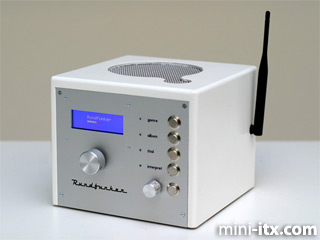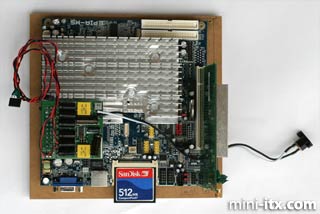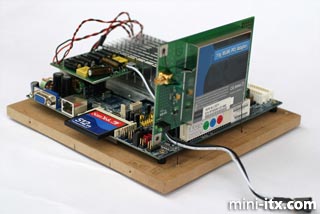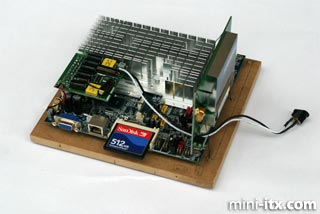Posted on February 18, 2006
Introduction
The Rundfunker is a tabletop mp3 player that scans the WLAN for local audio sources and is able to play shared audio-files. It has a built-in 2-way speaker system, a LCD display and a very simple yet powerful user interface. The device is independent of any external peripheral equipment - all hardware components are integrated into the appealingly designed housing including an exclusive aluminium front panel. All you need is 12 V DC power supplied e.g. by a mains adapter. The Rundfunker is driven by various parts we developed from scratch - such as a customized Linux, operating software implemented in Java and a circuit board for connection of hardware (LCD display and buttons). The idea of the Rundfunker was born at the FH Augsburg, University of Applied Sciences. Our 5-man team (Mathias Bauer, Christoph Beckmann, Christian Leberfinger, Stefan Loibl, Jan Peuker) has designed and implemented the entire software and has made it available as open source. Moreover we constructed two fully functional prototypes - all in all we worked about 5 months on this project.
The idea of developing a WLAN radio emerged from the desire to combine the advantages of a FM receiver with those of a personalised collection of music on a PC. A FM receiver usually is compact, portable and uncomplicated in use. Unfortunately the programme of the radio stations is not everyone's cup of tea. The mp3 files on a personal computer could be an alternative, however they have the huge drawback of normally being located on a more or less immobile computer. Thus they can hardly be heard beyond the four walls of the room the PC stands in (without annoying the neighbours).
Our Rundfunker is an elegant solution for this circumstance. It is a radio-shaped mp3 player that offers wireless access to all mp3s that are shared in the local network and thus isn't subject to the volume-restrictions of the popular mp3 USB sticks with unhandy tiny buttons that nowadays have a capacity of only few gigabytes. Via WLAN the Rundfunker can deal with huge audio-libraries with hypothetically unlimited size.
Rundfunker is mobile, yet not made for real portable use like Walkman and co - it shows its strength within the reach of the wireless home network: The device doesn't have to make do with an ultra-compact housing like an iPod, but consists of a cubic box (dimensions: 21×21×18 centimeters) that holds enough volume for the integrated 2-way speaker system, an exclusive aluminium front panel containing easy to use buttons and a clearly arranged LCD display.
A typical use case for the Rundfunker would be: the study in the upper floor has a PC with a hard disk filled with your most precious and well-sorted songs e.g. recorded from your old vinyl records. Your Rundfunker is situated in your kitchen and can play these mp3s via WLAN. The listener has various possibilities of influencing the playback. By means of the easy to use interface he can choose his favourite album or genre or simply browse through the entire collection of mp3s.
A power supply is the only thing you need to take the Rundfunker into operation. To enable the Rundfunker to play your songs, you can use the comfortable web interface and configure your IP-address and your shared audio-sources. You can also use the Java-Applet in the web interface to operate your Rundfunker by remote control.
Motherboard
We decided to use a completely passively cooled VIA EPIA motherboard. We agreed on buying the MS 10000E LVDS, because it offers serial and audio ports shaped as pin headers, a PCI slot and has a built in compact-flash connector that we use to boot Troubadix, our specially customized Knoppix derivative. Unfortunately, the 12V DC-DC ATX power supply unit we ordered didn't fit onto the board, because it interfered with the massive cooler of our EPIA. We first thought of using an ATX power extension, but fortunately our university's locksmith was able to perfectly mill the cooler the way we needed it. WLAN connectivity is offered by a PCI card - having quite a big antenna on the Rundfunker's side was our very intention and fixing it directly to the PCI card was the easiest way to achieve this aim.
 |
 |
 |
Quick Links
Mailing Lists:
Mini-ITX Store
Projects:
Show Random
Accordion-ITX
Aircraft Carrier
Ambulator 1
AMD Case
Ammo Box
Ammo Tux
AmmoLAN
amPC
Animal SNES
Atari 800 ITX
Attache Server
Aunt Hagar's Mini-ITX
Bantam PC
BBC ITX B
Bender PC
Biscuit Tin PC
Blue Plate
BlueBox
BMW PC
Borg Appliance
Briefcase PC
Bubbacomp
C1541 Disk Drive
C64 @ 933MHz
CardboardCube
CAUV 2008
CBM ITX-64
Coelacanth-PC
Cool Cube
Deco Box
Devilcat
DOS Head Unit
Dreamcast PC
E.T.PC
Eden VAX
EdenStation IPX
Encyclomedia
Falcon-ITX
Florian
Frame
FS-RouterSwitch
G4 Cube PC
GasCan PC
Gingerbread
Gramaphone-ITX-HD
GTA-PC
Guitar PC
Guitar Workstation
Gumball PC
Hirschmann
HTPC
HTPC2
Humidor 64
Humidor CL
Humidor II
Humidor M
Humidor PC
Humidor V
I.C.E. Unit
i64XBOX
i-EPIA
iGrill
ITX Helmet
ITX TV
ITX-Laptop
Jeannie
Jukebox ITX
KiSA 444
K'nex ITX
Leela PC
Lego 0933 PC
Legobox
Log Cabin PC
Lunchbox PC
Mac-ITX
Manga Doll
Mantle Radio
Mediabox
Mega-ITX
Micro TV
Mini Falcon
Mini Mesh Box
Mini-Cluster
Mobile-BlackBox
Moo Cow Moo
Mr OMNI
NAS4Free
NESPC
OpenELEC
Osh Kosh
Pet ITX
Pictureframe PC
Playstation 2 PC
Playstation PC
Project NFF
PSU PC
Quiet Cubid
R2D2PC
Racing The Light
RadioSphere
Restomod TV
Robotica 2003
Rundfunker
SaturnPC
S-CUBE
SEGA-ITX
SpaceCase
SpacePanel
Spartan Bluebird
Spider Case
Supra-Server
Teddybear
Telefunken 2003
TERA-ITX
The Clock
ToAsTOr
Tortoise Beetle
Tux Server
Underwood No.5
Waffle Iron PC
Windows XP Box
Wraith SE/30
XBMC-ION




